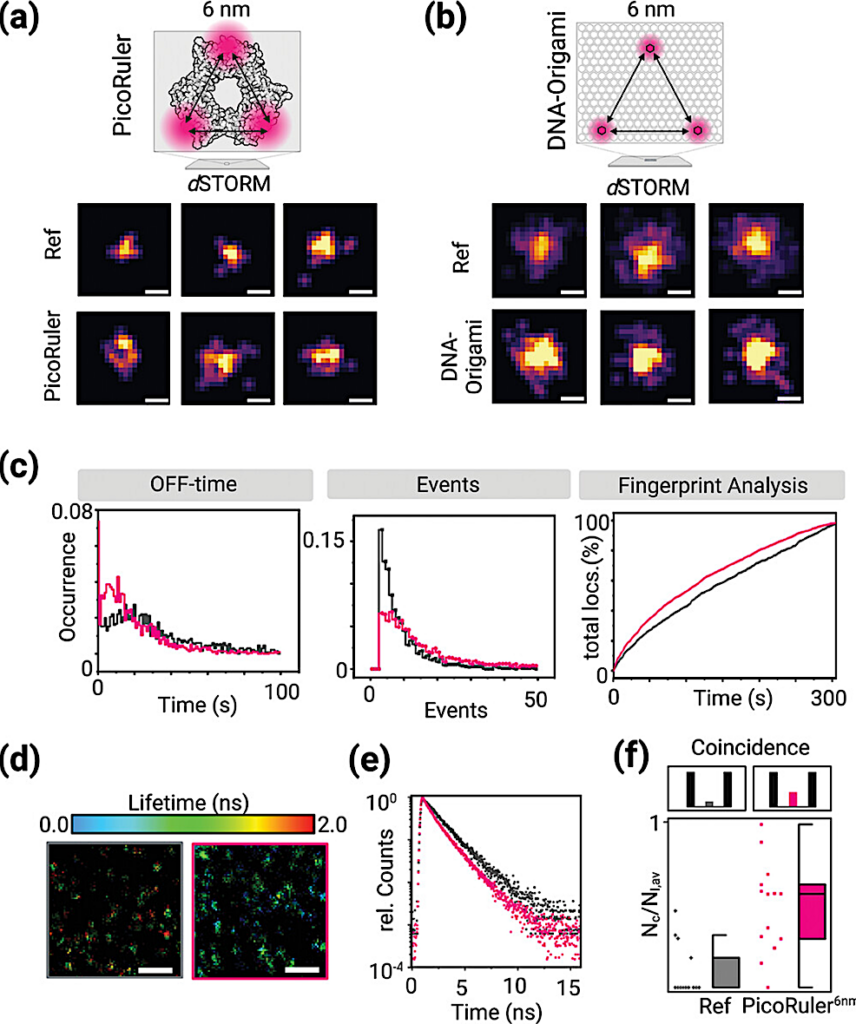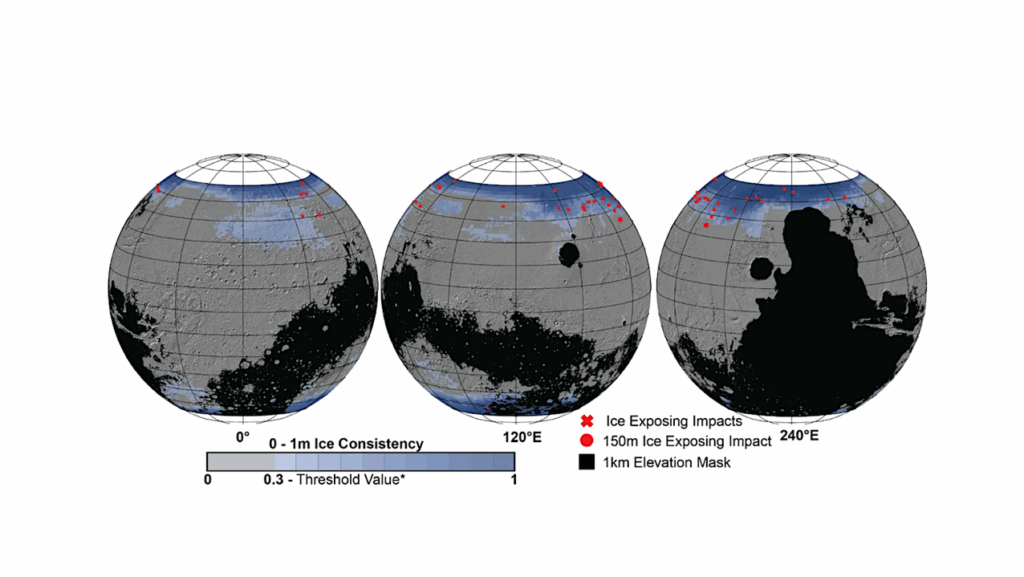Tricorder Tech: PicoRuler: Molecular Rulers For High-resolution Microscopy

Editor’s note: you and/or your robotic assistants are exploring a new world where life exists. You are trying to understand its basic genomics, cell structure, and other aspects of its most basic construction. You are very far from home and you need information to send home but also to guide your research sorties and laboratory studies on site. Having a tricorder / handheld sensor device that can collect such information and relay that information back to your home base to do super high resolution imaging could be a great tool. How will we equip our human and robotics explorers with imaging systems for these away team missions?
Latest super-resolution microscopy methods now achieve an optical resolution in the range of a few nanometres. This corresponds to a resolution in the range of the size of cellular molecules. However, it has not yet been possible to verify the resolution actually achieved on cellular building blocks such as multiprotein complexes – because there were no biomolecular reference systems that could be labelled with dyes at precisely defined positions at a distance of a few nanometres.
A team led by Dr Gerti Beliu and Professor Markus Sauer from the Rudolf Virchow Centre – Center for Integrative and Translational Bioimaging at Julius-Maximilians-Universität (JMU) Würzburg in Bavaria, Germany, has now provided a turning point. In the journal Advanced Materials, they present novel biocompatible molecular rulers, the PicoRulers (Protein-based Imaging Calibration Optical Rulers).
Using genetic code expansion and click chemistry, the team has succeeded in constructing these customised molecular rulers. They can be used as precise biomolecular reference structures in fluorescence microscopy.

Engineering a PCNA-based PicoRuler for sub-10 nm super-resolution microscopy. a) Depiction of the PCNA ruler design, showing the positions of three identical fluorophores at intervals of 6 nm. This was achieved through bioorthogonal click labeling of ncAAs, which were site-specifically introduced into PCNA through GCE. As a reference sample we used PCNA labeled with a DOL ≈0.4. b) SDS-PAGE illustrating the purity of the PCNA WT after each step of purification. L: protein ladder, His: after nickel affinity chromatography, Strep-Trap: after Strep-tag affinity chromatography and SEC: after size exclusion chromatography. The PCNA monomer band is marked by a red triangle. c) PCNA-6 (S186Norb) imaged by TEM under negative staining with uranyl acetate. d) SEC chromatogram of PCNA-6 (S186Norb) after labeling with H-Tet-Cy5, confirming the successful conjugation of the fluorophores to the PCNA protein. Fraction containing the labeled PicoRuler is shown in blue shading. Scale bar 5 nm (c) — Advanced Materials
Technological Masterpiece: Precision at Molecular Level
The PicoRulers are based on the three-part protein PCNA (Proliferating Cell Nuclear Antigen), which plays a central role in DNA replication and repair. Through the precise introduction of unnatural amino acids at precisely defined positions, this protein has been modified in such a way that fluorescent dyes or other molecules can be specifically clicked onto it with minimal linkage error.
This enables researchers to test the resolution of the latest super-resolution microscopy methods with unprecedented precision on a precisely defined cellular biomolecule.
Markus Sauer is enthusiastic: “The ability to resolve real biological structures at sub-10-nanometre level marks a new era in biological imaging. Compared to previously used artificial macromolecules, our PicoRulers are not only characterised by their biological compatibility. They also enable unrivalled precision for testing resolution under realistic conditions.”
Opening the Door to Investigate Complex Processes in Cells
The application of this technology extends far beyond the traditional boundaries of microscopy. “Our PicoRulers are not only a tool for more precise measurements, but also open the door to a deeper and more detailed investigation of complex processes that take place within our cells,” explains Gerti Beliu.

Photophysical evaluation of PCNA-based PicoRulers and DNA origami. a,b) Selected dSTORM images of triple-labeled (DOL ≈ 3.0) PicoRulers (a) and DNA origami (b) with interfluorophore distances of 6 nm, along with their singly-labeled reference samples (Ref). While each DNA origami contains a single fluorophore, the PCNA reference sample exhibits a DOL ≈0.4 and thus contains also unlabeled and dual-labeled PCNA molecules (pixel size 2 nm). Scale bars, 10 nm. c) Relative occurrence of lifetimes of the off-state (OFF-time), number of on-states (Events) detected from individual PicoRulers in dSTORM experiments and number of events (localizations) detected per frame as a function of time (Fingerprint Analysis). d) FLIM images of PicoRulers click-labeled with H-Tet-Cy5 (the singly labeled reference is shown in a grey and the triple-clicked PicoRuler in a magenta box) measured by confocal TCSPC imaging in photoswitching buffer at an irradiation intensity of ≈2.5 kW cm−2. To minimize photobleaching of fluorophores, FLIM images were recorded at 25 µs of integration time per pixel. No intensity threshold was applied. Scale bars, 2 µm. e) Average fluorescence decays from PCNA PicoRulers labeled with one (grey) or three (magenta) Cy5 fluorophores. f) Nc/Nl,av ratios determined for singly-labeled reference PCNA molecules and triple-labeled PicoRulers in photon antibunching experiments (n = 13) — Advanced Materials.
Strong Potential for Future Applications
The further development of the PicoRulers may change biological and medical imaging with molecular resolution in the long term. For the first time, they make it possible to validate and improve the resolution potential of new super-resolution microscopy methods on biological samples. This makes them a valuable tool for the future elucidation of the molecular organisation and interaction of biomolecules in cells.
PCNA as Protein-Based Nanoruler for Sub-10 nm Fluorescence Imaging, Advanced Materials (open access)
Astrobiology








